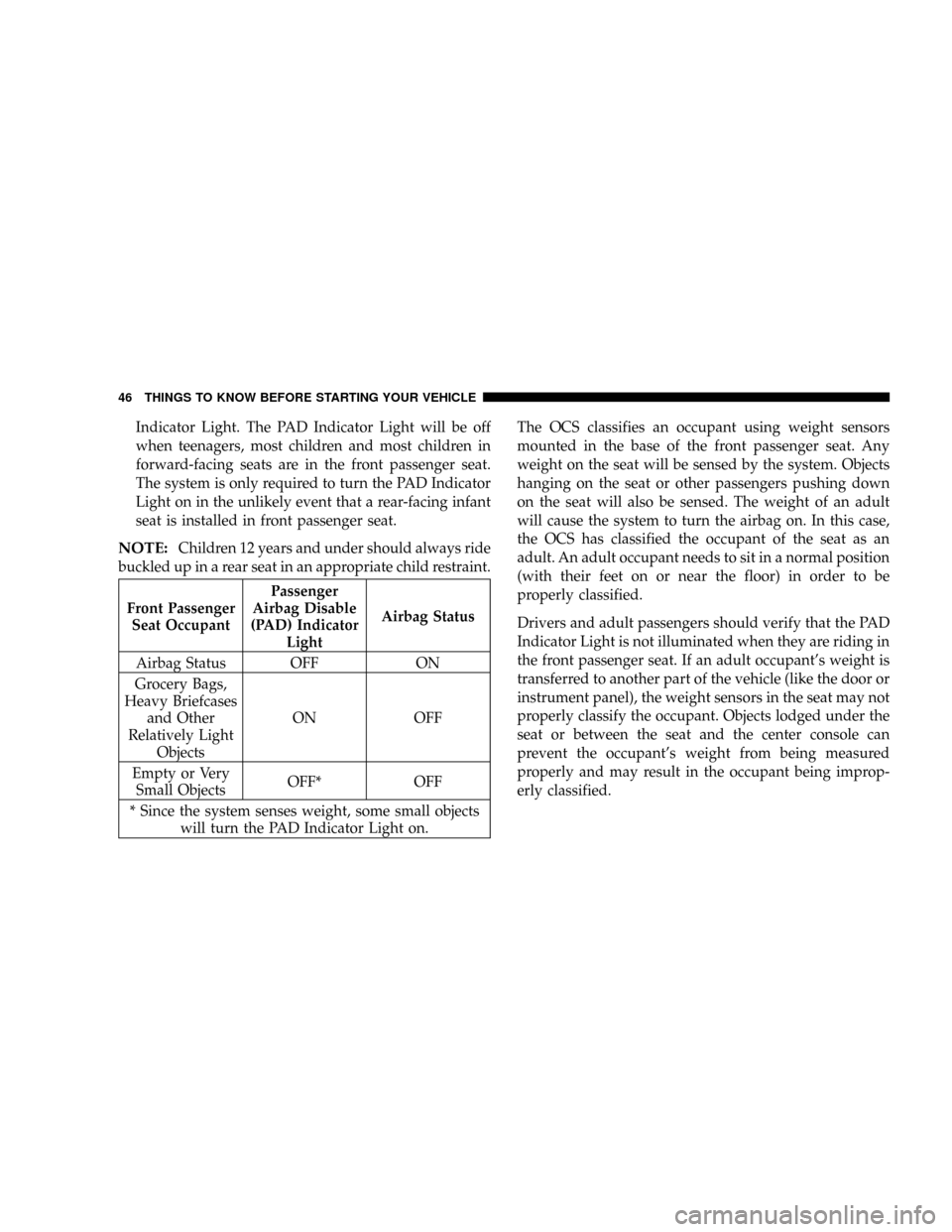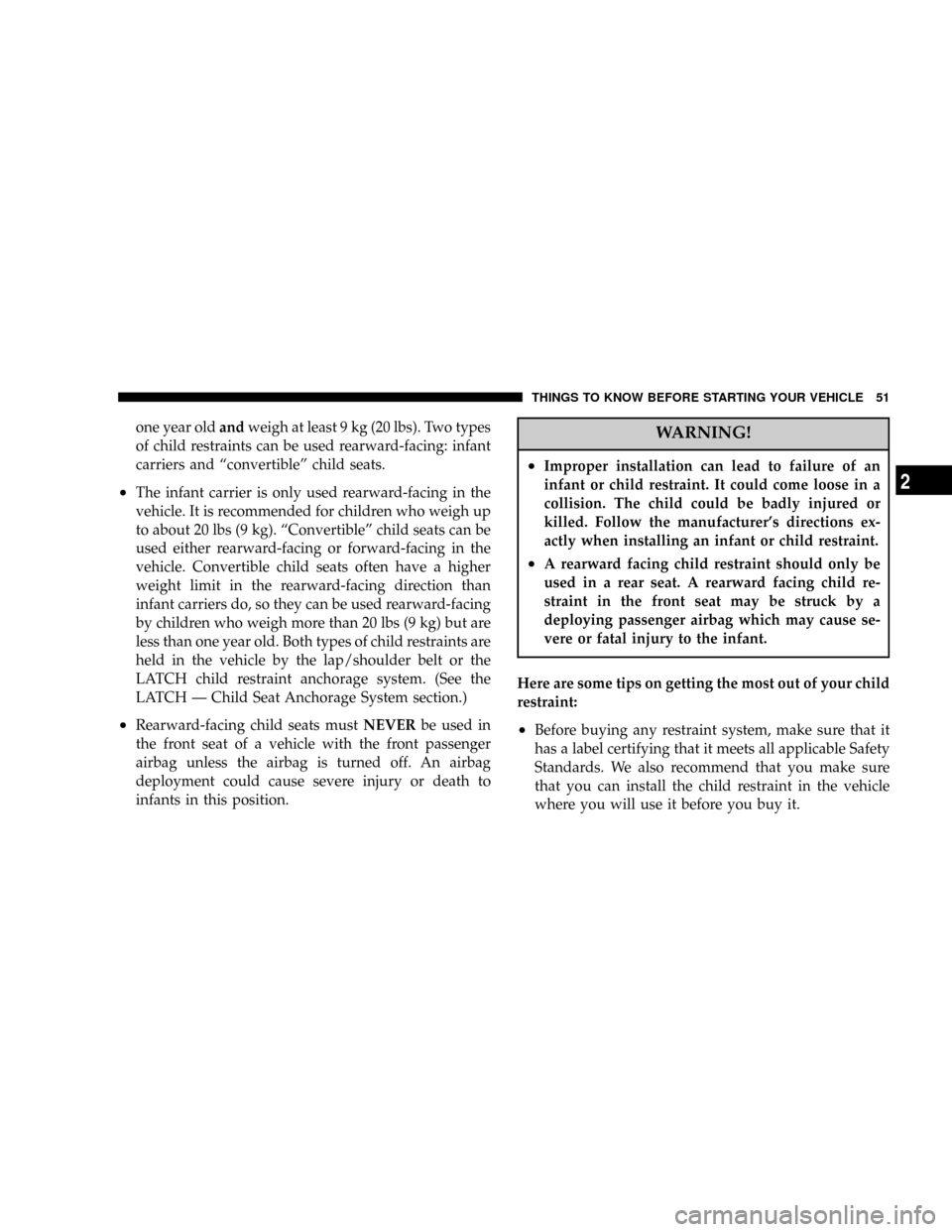2005 CHRYSLER 300 child restraint
[x] Cancel search: child restraintPage 29 of 374

Trunk Emergency Release
The trunk of your vehicle is equipped with an emergency
release handle. It is located on the inside of the trunk lid,
near the latch, and is coated so that it glows in a darkened
trunk. Pull on the handle to open the trunk.
OCCUPANT RESTRAINTS
Some of the most important safety features in your
vehicle are the restraint systems. These include the front
and rear seat belts for the driver and all passengers, front
airbags for both the driver and front passenger and, if so
equipped, left and right side curtain airbags for the
driver and passengers seated next to a window. If you
will be carrying children too small for adult-size belts,
your seat belts also can be used to hold infant and child
restraint systems.
Please pay close attention to the information in this
section. It tells you how to use your restraint system
properly to keep you and your passengers as safe as
possible.
THINGS TO KNOW BEFORE STARTING YOUR VEHICLE 29
2
Page 34 of 374

Adjustable Upper Shoulder Belt Anchorage
In the driver and front passenger seats, the shoulder belt
can be adjusted upward or downward to position the belt
away from your neck. Push and fully depress the button
above the webbing to release the anchorage, and then
move it up or down to the position that serves you best.
As a guide, if you are shorter than average, you will
prefer a lower position, and if you are taller than average,
you'll prefer a higher position. When you release the
anchorage, try to move it up or down to make sure that
it is locked in position.In the rear seat, move toward the center of the seat to
position the belt away from your neck.
Pretensioners
The seat belts for both front seating positions are
equipped with pretensioning devices that are designed to
remove any slack from the seat belts in the event of a
collision. These devices improve the performance of the
seat belt system by assuring that the belt is tight about the
occupant in a collision. Pretensioners work for all size
occupants, including those in child restraints.
NOTE:These devices are not a substitute for proper
seat belt placement by the occupant. The seat belt still
must be worn snugly and positioned properly.
The pretensioners are triggered by the airbag control
module (see Airbag Section). Like the front airbags, the
pretensioners are single use items. After a collision that is
severe enough to deploy the airbags and pretensioners,
both must be replaced.
34 THINGS TO KNOW BEFORE STARTING YOUR VEHICLE
Page 39 of 374

Here are some simple steps you can take to minimize
the risk of harm from a deploying airbag.
1. Children 12 years old and under should ride buckled
up in the rear seat. Infants in rear-facing child restraints
shouldNEVERride in the front seat of a vehicle with a
passenger front airbag. An airbag deployment could
cause severe injury or death to infants in that position.
Children that are not big enough to properly wear the
vehicle seat belt (see section on ªChild Restraintº) should
be secured in the rear seat in child restraints or belt-
positioning booster seats.
Older children who do not use child restraints or belt-
positioning booster seats should ride properly buckled
up in the rear seat. Never allow children to slide the
shoulder belt behind them or under their arm.If a child from 1 to 12 years old must ride in the front
passenger seat because the vehicle is crowded, move the
seat as far back as possible, and use the proper child
restraint. See the section on ªChild Restraintº.
2. You should read the instructions provided with your
child restraint to make sure that you are using it properly.
3. All occupants should use their seat belts properly.
4. The driver and front passenger seats should be moved
back as far as practical to allow the airbags time to inflate.
5. If your vehicle has left and right side curtain airbags,
do not lean against the door, airbags will inflate forcefully
into the space between you and the door.
THINGS TO KNOW BEFORE STARTING YOUR VEHICLE 39
2
Page 45 of 374

Occupant Classification System
²
TheOccupant Classification System (OCS)is part of
a Federally regulated safety system required for this
vehicle. It is designed to turn off the front passenger
airbag in the unlikely event that a rear-facing infant
seat is in the front passenger seat.
NOTE:Children 12 years and under should always ride
buckled up in a rear seat in an appropriate child restraint.
²ThePassenger Airbag Disable (PAD) Indicator Light
(an amber light located in the center of the instrument
panel) tells the driver and front passenger when the
front passenger airbag is turned off. The PAD Indica-
tor lamp illuminates the words9PASS AIRBAG OFF9
to show that the passenger airbag will not inflate
during a collision requiring airbags.This light should not be illuminated when an adult
passenger is properly seated in the front passenger
seat. In this case, the airbag is ready to be inflated if a
collision requiring an airbag occurs. The PAD Indica-
tor Light is also turned off when the seat is empty. The
only time that the PAD Indicator Light is turned on is
when a small weight is in the front passenger seat. The
system is required to turn on the PAD Indicator Light
when the weight in the front passenger seat is close to
a rear-facing infant seat. Relatively light objects like
brief cases and grocery bags will also turn on the PAD
THINGS TO KNOW BEFORE STARTING YOUR VEHICLE 45
2
Page 46 of 374

Indicator Light. The PAD Indicator Light will be off
when teenagers, most children and most children in
forward-facing seats are in the front passenger seat.
The system is only required to turn the PAD Indicator
Light on in the unlikely event that a rear-facing infant
seat is installed in front passenger seat.
NOTE:Children 12 years and under should always ride
buckled up in a rear seat in an appropriate child restraint.
Front Passenger
Seat OccupantPassenger
Airbag Disable
(PAD) Indicator
LightAirbag Status
Airbag Status OFF ON
Grocery Bags,
Heavy Briefcases
and Other
Relatively Light
ObjectsON OFF
Empty or Very
Small ObjectsOFF* OFF
* Since the system senses weight, some small objects
will turn the PAD Indicator Light on.The OCS classifies an occupant using weight sensors
mounted in the base of the front passenger seat. Any
weight on the seat will be sensed by the system. Objects
hanging on the seat or other passengers pushing down
on the seat will also be sensed. The weight of an adult
will cause the system to turn the airbag on. In this case,
the OCS has classified the occupant of the seat as an
adult. An adult occupant needs to sit in a normal position
(with their feet on or near the floor) in order to be
properly classified.
Drivers and adult passengers should verify that the PAD
Indicator Light is not illuminated when they are riding in
the front passenger seat. If an adult occupant's weight is
transferred to another part of the vehicle (like the door or
instrument panel), the weight sensors in the seat may not
properly classify the occupant. Objects lodged under the
seat or between the seat and the center console can
prevent the occupant's weight from being measured
properly and may result in the occupant being improp-
erly classified.
46 THINGS TO KNOW BEFORE STARTING YOUR VEHICLE
Page 50 of 374

²Seatbelt status
²Brake status (service and parking brakes)
²Accelerator status (including vehicle speed)
²Engine control status (including engine speed)
²Cruise control status
²Traction/stability control status
Child Restraint
Everyone in your vehicle needs to be buckled up all the
time, babies and children, too. Every state in the United
States and all Canadian provinces require that small
children ride in proper restraint systems. This is the law,
and you can be prosecuted for ignoring it.
Children 12 years and under should ride properly buck-
led up in a rear seat, if available. According to crash
statistics, children are safer when properly restrained in
the rear seats rather than in the front.
WARNING!
In a collision, an unrestrained child, even a tiny
baby, can become a missile inside the vehicle. The
force required to hold even an infant on your lap
could become so great that you could not hold the
child, no matter how strong you are. The child and
others could be badly injured. Any child riding in
your vehicle should be in a proper restraint for the
child's size.
There are different sizes and types of restraints for
children from newborn size to the child almost large
enough for an adult safety belt. Always check the child
seat Owner's Manual to ensure you have the right seat
for your child. Use the restraint that is correct for your
child:
Infants and Child Restraints
²
Safety experts recommend that children ride
rearward-facing in the vehicle until they are at least
50 THINGS TO KNOW BEFORE STARTING YOUR VEHICLE
Page 51 of 374

one year oldandweigh at least 9 kg (20 lbs). Two types
of child restraints can be used rearward-facing: infant
carriers and ªconvertibleº child seats.
²The infant carrier is only used rearward-facing in the
vehicle. It is recommended for children who weigh up
to about 20 lbs (9 kg). ªConvertibleº child seats can be
used either rearward-facing or forward-facing in the
vehicle. Convertible child seats often have a higher
weight limit in the rearward-facing direction than
infant carriers do, so they can be used rearward-facing
by children who weigh more than 20 lbs (9 kg) but are
less than one year old. Both types of child restraints are
held in the vehicle by the lap/shoulder belt or the
LATCH child restraint anchorage system. (See the
LATCH Ð Child Seat Anchorage System section.)
²Rearward-facing child seats mustNEVERbe used in
the front seat of a vehicle with the front passenger
airbag unless the airbag is turned off. An airbag
deployment could cause severe injury or death to
infants in this position.
WARNING!
²Improper installation can lead to failure of an
infant or child restraint. It could come loose in a
collision. The child could be badly injured or
killed. Follow the manufacturer's directions ex-
actly when installing an infant or child restraint.
²A rearward facing child restraint should only be
used in a rear seat. A rearward facing child re-
straint in the front seat may be struck by a
deploying passenger airbag which may cause se-
vere or fatal injury to the infant.
Here are some tips on getting the most out of your child
restraint:
²Before buying any restraint system, make sure that it
has a label certifying that it meets all applicable Safety
Standards. We also recommend that you make sure
that you can install the child restraint in the vehicle
where you will use it before you buy it.
THINGS TO KNOW BEFORE STARTING YOUR VEHICLE 51
2
Page 52 of 374

²The restraint must be appropriate for your child's
weight and height. Check the label on the restraint for
weight and height limits.
²Carefully follow the instructions that come with the
restraint. If you install the restraint improperly, it may
not work when you need it.
²Buckle the child into the seat according to the child
restraint manufacturer's directions.
²When your child restraint is not in use, secure it in the
vehicle with the seat belt or remove it from the vehicle.
Do not leave it loose in the vehicle. In a sudden stop or
collision, it could strike the occupants or seat backs
and cause serious personal injury.
NOTE:For additional information refer to
www.seatcheck.org or call 1±866±SEATCHECK.
Older Children and Child Restraints
Children who weigh more than 20 lbs (9 kg) and who are
older than one year can ride forward-facing in the
vehicle. Forward-facing child seats and convertible child
seats used in the forward-facing direction are for children
who weigh 20 to 40 lbs (9 to 18 kg) and who are older
than one year. These child seats are also held in the
vehicle by the lap/shoulder belt or the LATCH child
restraint anchorage system. (See the LATCH Ð Child
Seat Anchorage System Section.)
The belt-positioning booster seat is for children weighing
more than 40 lbs (18 kg), but who are still too small to fit
the vehicle's seat belts properly. If the child cannot sit
with knees bent over the vehicle's seat cushion while the
child's back is against the seat back, they should use a
belt-positioning booster seat. The child and belt-
positioning booster seat are held in the vehicle by the
lap/shoulder belt.
52 THINGS TO KNOW BEFORE STARTING YOUR VEHICLE